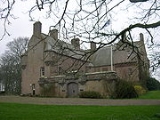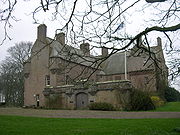
L Plan Castle
Encyclopedia

Middle Ages
The Middle Ages is a periodization of European history from the 5th century to the 15th century. The Middle Ages follows the fall of the Western Roman Empire in 476 and precedes the Early Modern Era. It is the middle period of a three-period division of Western history: Classic, Medieval and Modern...
. As building techniques improved, it became possible to construct a larger building footprint and a more complex shape than the simple blockhouse tower. A more compelling motivation for the L plan was the ability to defend the entrance door by providing covering fire from the adjacent walls. This stratagem was particularly driven by the advent of cannon used by attackers.
It was common for the union of the two wings to have very thick wall construction to support a major defensive tower in the union area. For example, the stone walls of Muchalls Castle
Muchalls Castle
Muchalls Castle stands overlooking the North Sea in the countryside of Kincardine and Mearns, Aberdeenshire, Scotland. The lower course is a well preserved double groined 13th century towerhouse structure, built by the Frasers of Muchalls. Upon this structure, the 17th century castle was begun by...
in Scotland are over 14 feet thick at the ground level. Built in the 13th century, these walls are thought to have supported a substantial defensive tower. A 17th century reconstruction consisted of a probably equally tall structure, but one suited toward 17th century living and whose upper story footprints mimicked the lower course.
Other examples of Scottish L-plan castles are Culzean Castle
Culzean Castle
Culzean Castle is a castle near Maybole, Carrick, on the Ayrshire coast of Scotland. It is the former home of the Marquess of Ailsa but is now owned by the National Trust for Scotland...
built in the late 16th century in Ayrshire; Dalhousie Castle
Dalhousie Castle
Dalhousie Castle is a castle in Midlothian, Scotland. Dalhousie Castle is situated near the town of Bonnyrigg, 8 miles south of Edinburgh. The castle was the seat of the Earls of Dalhousie, the chieftains of Clan Ramsay.-History:...
built as a 15th century towerhouse near Dalkeith in the Lothian region; Dunnottar Castle
Dunnottar Castle
Dunnottar Castle is a ruined medieval fortress located upon a rocky headland on the north-east coast of Scotland, about two miles south of Stonehaven. The surviving buildings are largely of the 15th–16th centuries, but the site is believed to have been an early fortress of the Dark Ages...
a partially ruined castle perched on a cliff by the North Sea near Stonehaven; Erchless Castle
Erchless Castle
Erchless Castle is an L-plan castle in northern Scotland, near Struy, Highland. The castle is located at the foot of Strathglass by the River Glass and River Farrar. Built in the 13th century by the Bissetts, it became into the hands of the Chisholms the 15th century, via the marriage of Alexander...
, a 14th century Norman Castle in Inverness-shire; Fernie Castle
Fernie Castle
Fernie Castle is an enlarged sixteenth century tower house in north-east Fife, Scotland.Situated just east of the village of Letham, it was originally in an L-plan layout...
constructed in the 16th century in Fife; and Neidpath Castle
Neidpath Castle
Neidpath Castle is an L-plan rubble-built tower house, overlooking the River Tweed about 1 mile west of Peebles in the Borders of Scotland. The castle is closed to the public.-History:...
built by Clan Fraser
Clan Fraser
Clan Fraser is a Scottish clan of French origin. The Clan has been strongly associated with Inverness and the surrounding area since the Clan's founder gained lands there in the 13th century. Since its founding, the Clan has dominated local politics and been active in every major military conflict...
in the 13th century near Peebles.
Irish L-plan castles include Balingarry Castle, which originated as a pre-Norman ringfort
Ringfort
Ringforts are circular fortified settlements that were mostly built during the Iron Age , although some were built as late as the Early Middle Ages . They are found in Northern Europe, especially in Ireland...
, but was modified as a high Middle Ages
Middle Ages
The Middle Ages is a periodization of European history from the 5th century to the 15th century. The Middle Ages follows the fall of the Western Roman Empire in 476 and precedes the Early Modern Era. It is the middle period of a three-period division of Western history: Classic, Medieval and Modern...
L-plan towerhouse; Balingarry Castle is located in the town of Balingarry. Gleninagh Castle is a 16th century towerhouse in a state of partial preservation. The L-plan design is also present in Rathmore Castle in County Meath.
As an eastern European example, one may look to Ilmov County, Romania to Herasti Castle, which includes elements of Italian Renaissance
Italian Renaissance
The Italian Renaissance began the opening phase of the Renaissance, a period of great cultural change and achievement in Europe that spanned the period from the end of the 13th century to about 1600, marking the transition between Medieval and Early Modern Europe...
design. In Cagliari, Sardinia are two surviving structures known as the Pisan Towers. Each of these towers, as well as a third structure destroyed by English and Spanish naval power, is an L-plan design. The structures date from the year 1217 and are each 30 meters in height. The towers served as important lookouts over the sea and toward the island interior.

